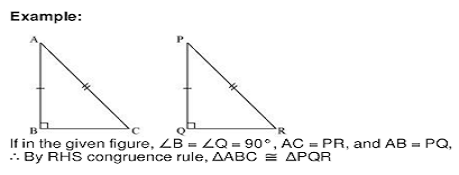NCERT Class 9 Maths Chapter 7 Triangles
Chapter 7 of NCERT Class 9 Maths textbook tells us about the world of triangles. A Triangle is one of the most familiar shapes which we are aware of since our childhood. This chapter teaches the students about different types of triangles and their properties. Questions frequently appear in the examinations from this chapter. Therefore it is crucial to prepare this chapter carefully.
Students can access customized study material designed for this chapter at GharPeShiksha. The material has the best Revision Notes, NCERT solutions, NCERT Exemplar Solutions, Previous Year Questions of this Chapter, Formulae Sheet, Model Answer Sheets designed by expert teachers. The study material is updated each year as per the syllabus requirements and is consistent with the new exam pattern. It also includes a lot of practice questions for the students. It is an exclusive feature that the students can avail of at GharPeShiksha only.
A triangle is a closed curve which is formed by 3 line segments. The line segments by which the triangle is formed are called sides of the triangle. The angles formed at the vertices are called the angles of the triangle.

Also, Angles opposite to equal sides are equal.
- A triangle is classified into different types based on their sides and angles.
- Equilateral Triangle- All three sides are equal
- Isosceles triangle- Any two sides are equal
- Scalene Triangle- All three sides are unequal
- Acute angled Triangle- All the interior angles are acute i.e. less than 90
- Right angle Triangle- One angle should be 90.
- Obtuse-angled Triangle- Any one of the angles is obtuse i.e. greater than 90.
Congruent Triangles
In a pair of triangles if all three corresponding sides and three corresponding angles are exactly equal, then the triangles are said to be congruent.
Congruence Criterion
SSS
SAS
AAS
ASA
- SSS Congruence criteria
If three sides of one triangle are equal to the three sides of another triangle, then the two triangles are congruent.

If all sides are exactly the same, then their corresponding angles must also be exactly the same.
- SAS Congruence criteria
Two triangles are congruent if two sides and the included angle of one triangle are equal to the corresponding sides and the included angle of the other triangle.

Therefore, by SAS congruency criterion, ![]() are congruent.
are congruent.
AAS Congruency criterion
Two triangles are said to be congruent to each other if two angles and one side of one triangle are equal to two angles and one side of the other triangle.

ASA Congruency criterion
If two angles and the included side of one triangle are equal to two angles and included side of another triangle, then the triangles are congruent.

RHS Congruence Rule:


Important Note:
SSA and AAA rules are not valid as the angle is not included between two equal sides for SSA.
When the two triangles are congruent, then their corresponding parts also become equal by CPCT.
CPCT stands for Corresponding Parts of Congruent Triangles. “Corresponding parts” means corresponding sides and angles of triangles.
Properties of Isosceles triangle
Isosceles triangle is the triangle having any two sides being equal. So, the angles opposite to equal sides are equal.
Inequalities in triangle
It says that if any two sides of a triangle are unequal, then the angle opposite to the longer side is longer and the angle opposite to the shorter side is shorter.
The converse is also true. If two angles are unequal in a triangle, then the side opposite to the greater angle is greater.
Have any Que
A triangle is a closed curve which is formed by 3 line segments. The line segments by which the triangle is formed are called sides of the triangle. The angles formed at the vertices are called the angles of the triangle.

Also, Angles opposite to equal sides are equal.
- A triangle is classified into different types based on their sides and angles.
- Equilateral Triangle- All three sides are equal
- Isosceles triangle- Any two sides are equal
- Scalene Triangle- All three sides are unequal
- Acute angled Triangle- All the interior angles are acute i.e. less than 90
- Right angle Triangle- One angle should be 90.
- Obtuse-angled Triangle- Any one of the angles is obtuse i.e. greater than 90.
Congruent Triangles
In a pair of triangles if all three corresponding sides and three corresponding angles are exactly equal, then the triangles are said to be congruent.
Congruence Criterion
SSS
SAS
AAS
ASA
- SSS Congruence criteria
If three sides of one triangle are equal to the three sides of another triangle, then the two triangles are congruent.

If all sides are exactly the same, then their corresponding angles must also be exactly the same.
- SAS Congruence criteria
Two triangles are congruent if two sides and the included angle of one triangle are equal to the corresponding sides and the included angle of the other triangle.

Therefore, by SAS congruency criterion, ![]() are congruent.
are congruent.
AAS Congruency criterion
Two triangles are said to be congruent to each other if two angles and one side of one triangle are equal to two angles and one side of the other triangle.

ASA Congruency criterion
If two angles and the included side of one triangle are equal to two angles and included side of another triangle, then the triangles are congruent.

RHS Congruence Rule:


Important Note:
SSA and AAA rules are not valid as the angle is not included between two equal sides for SSA.
When the two triangles are congruent, then their corresponding parts also become equal by CPCT.
CPCT stands for Corresponding Parts of Congruent Triangles. “Corresponding parts” means corresponding sides and angles of triangles.
Properties of Isosceles triangle
Isosceles triangle is the triangle having any two sides being equal. So, the angles opposite to equal sides are equal.
Inequalities in triangle
It says that if any two sides of a triangle are unequal, then the angle opposite to the longer side is longer and the angle opposite to the shorter side is shorter.
The converse is also true. If two angles are unequal in a triangle, then the side opposite to the greater angle is greater.



